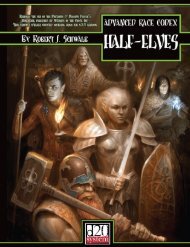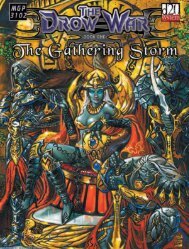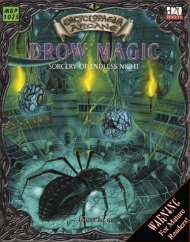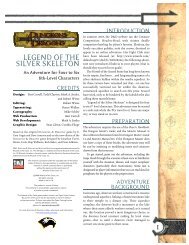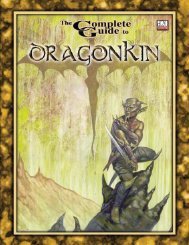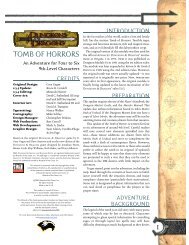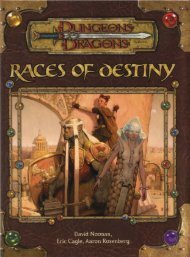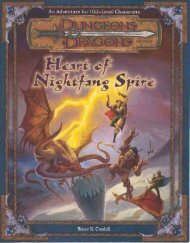You also want an ePaper? Increase the reach of your titles
YUMPU automatically turns print PDFs into web optimized ePapers that Google loves.
92<br />
to maintain its slaves, mercenaries, guards and servants.<br />
Hugely expensive and ridiculously over-protected, the<br />
fortress homes also serve as a balance to the threats of the<br />
Game of Bones. By holing up in such a sanctuary, a House<br />
can keep its members safe and out of harms way, though<br />
their influence will certainly wane if they remain too long<br />
out of touch.<br />
<strong>Drow</strong> Noble Houses are the primary combatants in<br />
the Sheathed War. <strong>The</strong>ir wealth, numerous agents and<br />
traditional role in drow society make them the most powerful<br />
organisations in any city of dark elves. Even in those cities<br />
with a single faith predominant, such as the web-strewn<br />
cities in the grip of the Dark Mother, the church would not<br />
dare move openly against a Noble House.<br />
Other Organisations<br />
While the drow nobles are easily the most powerful in<br />
drow society, they are not the only organisations with<br />
political clout. Merchant guilds, criminal conglomerates,<br />
temples, philosophical sects, information brokers such as<br />
the Seekers of na’Koth and even hidden revolutionaries all<br />
band together to play the Game of Bones, amassing power<br />
and influence in an effort to earn themselves a place in the<br />
brutal pecking order of a drow city. If a group can muster<br />
the Influence and Power (for a combined rank of at least<br />
1,000) they are able to enter the Game.<br />
Fighting the Sheathed War<br />
<strong>The</strong> Sheathed War is a combination of political strategy and<br />
brutal combat, with its mood shifting rapidly depending<br />
on the whims and desires of its combatants. In some<br />
cities, it is fought almost entirely in the back alleys and<br />
hidden meeting rooms as cabals spread damaging rumours<br />
about their rivals and draw upon the services of spies and<br />
informers to discover the secrets of their foes. In others,<br />
assassins launch brutal strikes against the members of<br />
Noble Houses and armed conflicts between entourages of<br />
enemy Houses are not uncommon, giving the name ‘<strong>The</strong><br />
Sheathed War’ a brutal irony the drow appreciate. Though<br />
none of the combatants wish to see their cities plunged into<br />
unending warfare and chaos, they dance uncomfortably<br />
close to the edge from time to time.<br />
In play terms, the Game of Bones is carried out in monthlong<br />
phases and each Player in the Game is able to make a<br />
number of actions during each phase, based on their rank,<br />
available resources and number of available lieutenants.<br />
<strong>The</strong> most powerful Noble House in a city is helpless to act<br />
if all its local leaders have been assassinated or otherwise<br />
rendered incapacitated and, likewise, a House with<br />
many leaders but little gold is going to have a hard time<br />
Aggressors, Defenders and Target Areas<br />
Throughout this section, you will see references to<br />
aggressors, defenders and target areas. <strong>The</strong> aggressor<br />
in the action is always the Noble House (or other<br />
organisation) who takes the action during the phase. <strong>The</strong><br />
defender, naturally, is the Noble House that is the target of<br />
the action.<br />
Target areas are typically city districts or other holdings<br />
that provide influence, power and money to the controlling<br />
Noble House.<br />
mobilising any sort of serious effort in the Game of Bones.<br />
Maintaining a balance of things is difficult, but there is no<br />
other way to rise in prominence in drow society.<br />
Lieutenants<br />
A Noble House or other organisation normally has a leader,<br />
but it must also have a number of lieutenants in order for<br />
the House to use its Power and Influence effectively. For<br />
Noble Houses, this is normally a matter of the family being<br />
involved in the action – while drow families are often<br />
rife with internecine struggles, it is generally accepted<br />
wisdom that members of the same Noble House will work<br />
together to further the interests of the House, an extension<br />
of the drow mentality that allows the fractious race to bind<br />
together to fight outside aggressors.<br />
Organisations other than Noble Houses tend to recruit their<br />
lieutenants from the friends and trusted allies of the leader.<br />
Wherever they come from, an organisation must have at<br />
least one lieutenant for every action it takes after the first<br />
in any given month. This lieutenant must possess levels or<br />
Hit Dice equal to or more than the House or organisation’s<br />
Rank minus five. It is the lieutenant’s skill which is used<br />
when an action is taken.<br />
Taking Action<br />
<strong>The</strong> rank of a Noble House (a combination of its Power and<br />
Influence) is a rough measure of its ability to get what it<br />
wants in the Game of Bones. More powerful Houses (those<br />
with a higher rank) are able to act more frequently within<br />
the Game, separating their vast resources to further their<br />
own plots or deal with the transgressions of their enemies.<br />
Smaller organisations must instead focus their meagre<br />
resources on fewer possible actions, because they lack the<br />
manpower to do otherwise.




